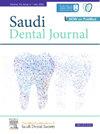Efficiency of bulk-fill versus conventional resin-based composite in class II restorations: A dental student perspective
IF 1.7
Q3 DENTISTRY, ORAL SURGERY & MEDICINE
引用次数: 0
Abstract
Purpose/objectives
The aim of the study was to evaluate the effect of two distinct light-polymerization protocols, used by dental students, on the placement time and polymerization efficiency of bulk-fill (BF) and conventional (CRC) resin-based composites (RBCs).
Methods
Thirty dental students participated in this study. Each student was asked to complete four Class II RBC restorations using two different types of RBCs (BF and CRC) paired with two distinct light-polymerization protocols: one using 1200 mW/cm2 irradiance (P1200) and one using 800 mW/cm2 irradiance (P800). Manufacturer instructions for curing times relative to these irradiance levels were adhered to. The restorations were retrieved, sectioned and Vickers microhardness (VMH) was measured at specific reading points. The placement time was recorded for each procedure. Multivariate analysis of variance and Bonferroni post hoc test were used for data analysis.
Results
Bulk-fill RBCs were associated with significantly shortened placement times (P < 0.001). VMH values of CRC-P800 were significantly higher compared to all other groups (P < 0.02). Across all groups tested, the VMH values at the deepest reading points exceeded those at the occlusal surfaces by over 80 %.
Conclusions
The use of BF RBCs with a P1200 light-polymerization protocol reduced students’ procedural times while maintaining effective polymerization of the restorations.
二类修复体中大量填充与传统树脂基复合材料的效率对比:牙科学生的视角
目的/目标 该研究旨在评估牙科学生使用两种不同的光聚合方案对大量填充型(BF)和传统型(CRC)树脂基复合材料(RBC)的放置时间和聚合效率的影响。每位学生被要求使用两种不同类型的 RBC(BF 和 CRC),搭配两种不同的光聚合方案完成四次二级 RBC 修复:一种使用 1200 mW/cm2 辐照度(P1200),另一种使用 800 mW/cm2 辐照度(P800)。这些辐照度水平的固化时间均遵守制造商的说明。取回修复体,切片并在特定读数点测量维氏硬度(VMH)。记录每个程序的贴片时间。数据分析采用了多变量方差分析和 Bonferroni 事后检验。结果充填粉末的 RBC 与镶牙时间的显著缩短有关(P < 0.001)。与所有其他组相比,CRC-P800 的 VMH 值明显更高(P < 0.02)。在所有测试组中,最深读数点的 VMH 值比咬合面的 VMH 值高出 80% 以上。结论使用 BF RBCs 和 P1200 光聚合方案可以缩短学生的操作时间,同时保持修复体的有效聚合。
本文章由计算机程序翻译,如有差异,请以英文原文为准。
求助全文
约1分钟内获得全文
求助全文
来源期刊

Saudi Dental Journal
DENTISTRY, ORAL SURGERY & MEDICINE-
CiteScore
3.60
自引率
0.00%
发文量
86
审稿时长
22 weeks
期刊介绍:
Saudi Dental Journal is an English language, peer-reviewed scholarly publication in the area of dentistry. Saudi Dental Journal publishes original research and reviews on, but not limited to: • dental disease • clinical trials • dental equipment • new and experimental techniques • epidemiology and oral health • restorative dentistry • periodontology • endodontology • prosthodontics • paediatric dentistry • orthodontics and dental education Saudi Dental Journal is the official publication of the Saudi Dental Society and is published by King Saud University in collaboration with Elsevier and is edited by an international group of eminent researchers.
 求助内容:
求助内容: 应助结果提醒方式:
应助结果提醒方式:


